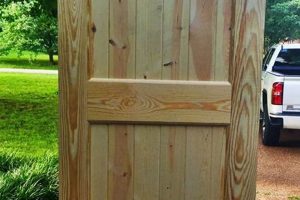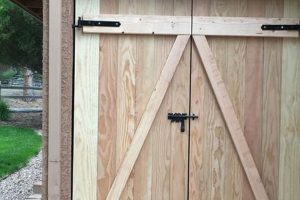Creating a sliding door reminiscent of agricultural architecture utilizing cost-effective methods and self-driven construction is a popular home improvement project. This approach allows homeowners to achieve a rustic aesthetic without incurring substantial professional installation costs. A prime example includes using reclaimed wood and readily available hardware to build and mount the door independently.
This method offers several advantages, including significant savings compared to purchasing pre-made doors or hiring professional installers. It also provides an opportunity for customization, enabling homeowners to tailor the door’s size, style, and finish to perfectly match their existing decor. Historically, such resourceful building techniques have been essential for homeowners seeking to personalize their living spaces while adhering to budgetary constraints.
The following sections will explore different materials and construction techniques suitable for this type of project, focusing on maximizing value and minimizing expenses. Subsequent details will address sourcing affordable hardware, ensuring proper installation, and achieving a desired aesthetic effect.
Strategies for Economical Sliding Door Construction
The following recommendations aim to assist in constructing a sliding door inspired by rural architecture using budget-conscious methods, emphasizing affordability and durability.
Tip 1: Source Reclaimed Materials: Repurposing lumber from deconstructed buildings or salvaged sources can significantly reduce material costs. Prioritize wood in good structural condition and appropriately treat it to prevent pests or decay.
Tip 2: Utilize Standard Hardware: Opting for standard-sized tracks and rollers, rather than specialized or decorative options, often provides substantial cost savings. Ensure compatibility and weight rating are appropriate for the door’s size and material.
Tip 3: Simplify the Design: Intricate designs demand more materials and increased labor time. A straightforward, panel-style door reduces waste and simplifies the assembly process, lowering the overall expense.
Tip 4: Employ Basic Joinery Techniques: Simple techniques such as screwing or using pocket screws offer adequate strength for most applications without requiring specialized tools or extensive woodworking expertise.
Tip 5: Explore Affordable Finishing Options: Instead of expensive stains or sealants, consider using milk paint or a diluted acrylic paint for a rustic finish at a lower price point. Adequate preparation, like sanding, is still crucial for even application.
Tip 6: Implement a Detailed Budget: Create a comprehensive budget prior to initiating the project, listing all anticipated costs, including materials, hardware, and tools. This enables better financial management and prevents unexpected expenses.
Tip 7: Seek Out Online Resources: Consult online forums, videos, and articles to gain practical insights and troubleshooting advice from experienced DIYers. This facilitates problem-solving and reduces the risk of costly mistakes.
Adhering to these strategies can greatly reduce the financial investment required for this type of project, while still producing a functional and aesthetically pleasing addition to a living space.
The next section will address common challenges encountered during the construction phase and provide guidance on avoiding potential pitfalls.
1. Material Sourcing
Material sourcing is a critical determinant in achieving a cost-effective rural-inspired sliding door. The selection of materials directly impacts the overall project expense, and strategic sourcing can significantly reduce financial outlay. This is a cornerstone of the cheap barn door diy approach. For instance, utilizing reclaimed wood, often available at a fraction of the cost of new lumber, immediately lowers expenses. This represents a direct causal relationship: affordable materials lead to a more economical final product.
Consider the practical application of sourcing reclaimed lumber from deconstructed barns or older homes. While requiring more preparation (cleaning, sanding, and treating), this method provides substantial savings compared to purchasing new wood from a lumberyard. Another example involves sourcing hardware from salvage yards or online marketplaces specializing in discounted or surplus items. This reduces the reliance on retail outlets with higher markups, leading to reduced costs. The importance of this concept extends to minimizing transportation costs by sourcing materials locally whenever possible.
In summary, material sourcing is fundamentally linked to the affordability of creating a sliding door. By prioritizing reclaimed materials, utilizing alternative hardware sources, and focusing on local availability, individuals can significantly reduce the overall project cost. Challenges include the time and effort required to prepare reclaimed materials, which must be factored into the cost-benefit analysis. Ultimately, mastering material sourcing is essential for anyone pursuing the rural-inspired sliding door aesthetic on a limited budget.
2. Hardware economy
Hardware economy represents a significant factor in achieving an affordable, rural-inspired sliding door. The selection and sourcing of hardware directly impacts the total project cost. Prioritizing functional, less decorative components is a primary cost-saving strategy. Standard rollers, tracks, and mounting brackets, often available at lower price points than specialized or ornate versions, adequately fulfill the essential function of enabling smooth door operation. The economic impact of selecting such hardware can be substantial, significantly reducing overall project expenditures.
For instance, consider the alternative between purchasing a custom-designed track system with intricate detailing versus a standard, galvanized steel track available at a building supply store. While the former enhances visual appeal, it also introduces a considerable cost increase. In many applications, the standard track provides equivalent functionality at a fraction of the price. Similarly, utilizing basic gate latches or simple door pulls instead of designer hardware contributes to significant savings. This approach reflects a pragmatic allocation of resources, prioritizing core functionality over purely aesthetic enhancements to ensure the feasibility of this kind of project.
In summary, Hardware economy is inextricably linked to achieving affordability in sliding door construction. By opting for standard, functional components over decorative or specialized hardware, individuals can effectively manage project expenses without compromising the core functionality of the door. Challenges may arise in balancing cost savings with aesthetic preferences, requiring a nuanced approach to hardware selection. However, a clear understanding of the economic implications of hardware choices is essential for individuals pursuing this kind of project on a budget.
3. Design Simplicity
Design simplicity, in the context of creating a cost-effective rural-inspired sliding door, is a critical factor influencing project affordability and feasibility. A simplified design reduces material waste, minimizes labor time, and decreases the skill level required for successful execution, directly contributing to lower overall costs.
- Reduced Material Requirements
Simpler designs, such as basic panel configurations or straightforward plank arrangements, necessitate fewer materials than elaborate or intricate patterns. This translates directly into lower lumber and hardware expenses. For instance, a door composed of vertically aligned planks requires less cutting and shaping than a complex geometric design, minimizing material waste and reducing the need for specialized tools. This streamlined approach results in a more economical project.
- Simplified Construction Process
A simplified design streamlines the construction process, reducing the time and effort required for assembly. Straight cuts, basic joinery techniques (e.g., screwing or pocket-hole joinery), and straightforward assembly procedures contribute to faster project completion. The decreased labor time translates into lower costs, particularly if professional assistance is not required. A complex design demands greater precision, more intricate joinery, and potentially specialized tools, increasing both the time and expense involved.
- Lower Skill Level Requirement
Simplified designs are inherently more accessible to individuals with limited woodworking experience. Basic construction techniques and straightforward assembly procedures require a lower level of skill than intricate designs involving complex cuts, precise joinery, or specialized finishing techniques. This allows more individuals to undertake the project independently, eliminating the need for professional assistance and reducing overall costs. A complex design, conversely, may necessitate the expertise of a skilled carpenter or woodworker, adding significantly to the project’s expense.
- Enhanced Durability and Maintainability
Paradoxically, simplicity often enhances a product’s robustness. With fewer intricate components to fail or become damaged, a more straightforward design can provide a greater lifespan and allow for easier maintenance or repairs. For example, a door comprised of solid planks with minimal joinery is inherently more durable than a multi-layered, decorative design. This translates to lower long-term costs as less frequent repairs or replacements are needed.
In conclusion, the concept of design simplicity plays a crucial role in achieving the objective of a cost-effective rural-inspired sliding door. By minimizing material usage, simplifying construction processes, lowering the skill level required, and enhancing durability, a straightforward design directly contributes to reduced project costs and increased accessibility. This approach ensures that a rural-inspired aesthetic can be achieved without incurring significant expenses, making it a viable option for budget-conscious homeowners.
4. Joint efficiency
Joint efficiency, concerning the creation of economical, rural-style sliding doors, refers to the optimization of connection methods to maximize structural integrity while minimizing material usage, labor time, and the need for specialized tools. Its relevance stems from the direct impact joinery techniques have on the overall cost and complexity of construction.
- Simplified Fastening Methods
The selection of fastening methods directly influences both material costs and labor requirements. Employing screws, nails, or pocket screws instead of more complex joinery (e.g., mortise and tenon, dovetails) streamlines the assembly process. These simplified methods require minimal specialized tools and training, reducing the time and expense associated with construction. For example, using construction screws to attach planks to a backing frame is far more expedient and cost-effective than creating traditional mortise and tenon joints for each connection. This approach prioritizes functionality and ease of execution, aligning with the cost-conscious nature of this project.
- Material Optimization
Efficient joinery reduces the overall material requirements of the door. By minimizing the overlap or waste inherent in certain joint designs, less lumber is needed to achieve the desired structural strength. For instance, utilizing butt joints reinforced with metal straps consumes less material than creating complex interlocking joints that require significant wood removal. This approach not only reduces material costs but also simplifies the cutting and shaping process, further contributing to efficiency.
- Tooling and Skill Requirements
Joint efficiency minimizes the need for specialized tools and advanced woodworking skills. Simplified joinery techniques can be executed with basic hand tools or readily available power tools, such as a drill, saw, and screwdriver. This reduces the initial investment in expensive equipment and eliminates the need for specialized training or professional assistance. For example, constructing a simple frame-and-panel door using pocket-hole joinery requires only a drill, pocket-hole jig, and screws, making it accessible to individuals with limited woodworking experience.
- Structural Integrity and Durability
While emphasizing simplicity, joint efficiency must not compromise the structural integrity and durability of the door. Proper selection and execution of joinery techniques are crucial for ensuring the door’s ability to withstand regular use and environmental factors. For instance, adequately spacing and securing screws or nails is essential for preventing the planks from separating or warping over time. Employing appropriate adhesives or sealants can further enhance the strength and weather resistance of the joints. This balance between simplicity and structural integrity is paramount for creating a long-lasting, cost-effective product.
In summary, joint efficiency plays a pivotal role in achieving the goals of a low-cost, rural-inspired sliding door. By optimizing fastening methods, minimizing material usage, reducing tooling and skill requirements, and ensuring structural integrity, efficient joinery techniques contribute significantly to project affordability and accessibility. This approach allows individuals with limited resources and experience to create a functional and aesthetically pleasing sliding door without incurring excessive costs or demanding specialized expertise.
5. Finishing options
The selection of finishing options exerts a considerable influence on the overall cost of a rural-inspired sliding door project. The type of finish applied to the door not only affects its aesthetic appearance but also impacts the material expenses and labor intensity involved. Cost-effective approaches necessitate prioritizing finishes that are readily available, easily applied, and require minimal surface preparation. The causal link between finishing choices and overall cost is direct; expensive, specialized finishes inevitably increase the financial burden of the project. For example, opting for a simple, oil-based stain instead of a multi-layer lacquer finish can substantially reduce material costs and application time.
The application of milk paint, a relatively inexpensive and readily available option, exemplifies a practical approach to finishing. Milk paint offers a rustic aesthetic and requires minimal surface preparation, further reducing labor costs. Another example includes using diluted acrylic paint to achieve a distressed look, effectively mimicking the appearance of more expensive aged finishes. In contrast, applying high-end varnishes or specialized wood sealants often necessitates extensive sanding and multiple coats, significantly increasing both material and labor expenses. These variations underscore the importance of carefully evaluating the cost implications of different finishing options.
In summary, the proper selection of finishing options is essential for achieving an affordable, rural-inspired sliding door. By prioritizing readily available, easily applied, and cost-effective finishes, individuals can significantly reduce the financial burden of the project without sacrificing aesthetic appeal. The challenge lies in balancing cost considerations with the desired visual outcome, requiring a careful evaluation of available options and their respective cost implications. The skillful navigation of finishing options is integral to the successful execution of this particular type of DIY project.
6. Budget adherence
Budget adherence is intrinsically linked to the successful execution of a low-cost, rural-inspired sliding door project. The phrase itself represents a commitment to remain within pre-determined financial limits. A well-defined budget serves as a roadmap, guiding material selection, design choices, and construction methods. Failure to adhere to the budget undermines the project’s primary objective of affordability. The absence of a budget or its disregard often results in escalating costs, ultimately defeating the purpose of a cheap barn door diy approach. This principle highlights a cause-and-effect relationship: controlled spending directly leads to a project that remains within its intended financial scope.
For instance, consider a project initiated with a pre-established budget of $150. This figure dictates the selection of reclaimed lumber over new, limits hardware to standard, non-decorative options, and encourages simple, efficient construction techniques. If, however, the project veers from this plan and incorporates expensive hardware or high-grade lumber, the initial budget becomes irrelevant, and the final cost escalates. A real-life example involves substituting reclaimed lumber with new pine at a cost increase of $50, followed by selecting premium rollers and track systems instead of basic hardware, adding an additional $40. This deviation results in a project cost overrun exceeding 60%. The practical significance underscores the necessity of prioritizing needs over wants and sticking to planned resources.
In summary, budget adherence is not merely a guideline but a fundamental requirement for a successful cheap barn door diy project. It ensures that cost considerations remain central to decision-making throughout the process. Potential challenges include unexpected material price increases or unforeseen construction complexities, which necessitate careful planning and contingency budgeting. This principle connects to the broader theme of responsible resource management and achieving desired outcomes within constrained financial parameters.
7. Online resources
Online resources represent a crucial element in achieving a successful and inexpensive barn door construction project. The internet provides access to a wealth of information, tutorials, and community support, empowering individuals to undertake the project independently and minimize expenses. Without access to these online materials, the feasibility of completing a “cheap barn door diy” project is significantly diminished. A direct cause-and-effect relationship exists: readily available online resources lower the barriers to entry, making the project accessible to a wider range of individuals with varying skill levels and budgets. Examples include step-by-step video tutorials demonstrating construction techniques, online forums dedicated to DIY home improvement, and websites offering free downloadable plans and templates. The ability to access this information remotely and at no cost fundamentally alters the accessibility of the project.
Practical application of these online resources extends from initial planning to troubleshooting unexpected challenges during construction. Individuals can research optimal material choices, explore alternative construction methods, and identify cost-effective hardware solutions. Online forums allow users to post questions, share experiences, and receive guidance from more experienced DIYers, mitigating the risk of costly mistakes. Moreover, online marketplaces offer opportunities to source materials and hardware at discounted prices, further contributing to cost savings. The aggregation of diverse perspectives and experiences online provides a valuable resource for overcoming obstacles and refining project execution. A practical example includes the use of online forums to identify solutions for uneven floor surfaces, prompting the selection of adjustable roller systems.
In summary, online resources serve as an indispensable component of the cheap barn door diy approach. They reduce the need for professional assistance, provide access to affordable materials, and facilitate the sharing of knowledge and best practices. Challenges arise from the need to critically evaluate the reliability and accuracy of online information; discernment and verification are essential. Nonetheless, the availability of online resources fundamentally democratizes access to this type of project, empowering individuals to achieve aesthetically pleasing and functional results without exceeding budgetary constraints.
Frequently Asked Questions
The following questions address common concerns and practical considerations associated with constructing a sliding door, inspired by rural aesthetics, while adhering to budgetary constraints.
Question 1: Is it genuinely possible to build a functional and aesthetically pleasing sliding door on a tight budget?
Achieving functionality and aesthetic appeal within a limited budget necessitates careful planning and resourcefulness. Utilizing reclaimed materials, simplifying design, and opting for standard hardware significantly reduces expenses.
Question 2: What are the most common pitfalls to avoid when attempting a cheap barn door DIY project?
Common pitfalls include underestimating material quantities, neglecting proper surface preparation, and failing to accurately measure dimensions. These errors often lead to increased material costs and project delays.
Question 3: How can I ensure the structural integrity of a sliding door constructed with reclaimed materials?
Thorough inspection of reclaimed materials is crucial. Damaged or weakened wood should be discarded. Employing appropriate joinery techniques and reinforcing connections with screws or metal straps enhances structural stability.
Question 4: What are the most cost-effective alternatives to traditional wood stains and sealants?
Milk paint and diluted acrylic paints offer affordable alternatives to traditional wood stains. These options provide adequate protection and aesthetic appeal at a lower price point.
Question 5: How critical is accurate measurement in the construction of a sliding door?
Accurate measurement is paramount. Inaccurate dimensions can result in ill-fitting doors, misalignment, and increased material waste. Double-checking all measurements is highly recommended.
Question 6: Where can one reliably source affordable hardware for a sliding door project?
Salvage yards, online marketplaces, and building supply stores often offer discounted or surplus hardware. Comparing prices and considering used or refurbished components can yield significant savings.
Successfully navigating these considerations greatly increases the likelihood of constructing a functional and visually appealing sliding door within a constrained budget.
The next section will provide a step-by-step guide to constructing a simple and affordable sliding door.
Cheap Barn Door DIY
This discussion has explored the multifaceted aspects of cost-effective, rural-inspired sliding door construction. The examination encompassed material sourcing strategies, hardware economy considerations, design simplification techniques, efficient joinery methods, affordable finishing options, the criticality of budget adherence, and the importance of leveraging online resources. Each element contributes to the feasibility of achieving a functional and aesthetically pleasing result within limited financial constraints.
The pursuit of a cheap barn door diy should be approached with diligent planning and resourceful execution. While the strategies outlined offer a viable path to achieving a desired aesthetic without excessive expense, careful consideration of individual skill levels, available resources, and potential challenges is essential. The future of this approach likely involves greater reliance on sustainable materials and innovative, cost-effective construction techniques, further democratizing access to personalized home improvement. Careful adherence to responsible practices will ensure its continued success and broader adoption.







